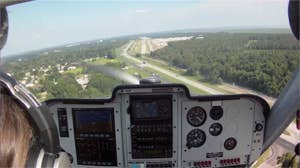
Runway 15 Approach at Orlando-Apopka
(see video below)
After completing several flights, it's clear that the decision to train much closer to home at First Landings Aviation, Orlando-Apopka, was a sound one. Florida's temperamental thunderstorms have arrived and the proximity has allowed me to reschedule canceled flights easily. And I'm really enjoying flying an LSA and the more flexible training environment. The Remos is a lot of fun and, boy, how different it is from the PA-28, from stick inputs to landing attitudes.
It all became immediately apparent on my first lesson. We took the doors off (love that!) and headed out to the north shore of Lake Apopka to work on heading maneuvers and slow flight. It was a beautiful morning with little wind and the familiar fertile farmlands below us rounded out the peacefulness and a certain sense of freedom. Compared to the PA-28, slow flight in the Remos was “nothing”. Maneuvering the airplane required minimum pitch and roll inputs (which takes practice!), and I was reminded how you feel every bump in the smaller airplanes.
On the way back to Orlando-Apopka to begin working on landings, we checked out Bob White Field … from above the only thing blatantly different that I noticed since I last looked upon it some 18 years ago was a couple of added hangars and the windsock location. It used to be near the house, located just south of the runway about a third of the way up from the east end. Now it sits near the east end of the runway, on the north side. It was strange to be looking down at the place — it seems like another lifetime yet not.
My first landings in the Remos produced quite a different site picture than I was used to — one of speeding toward the ground — and it was a bit disconcerting! Adam explained that the airplane becomes very mushy at the POH recommended approach speed of 59 mph and that the airplane handles better at 70 mph with a nose-down attitude and a later-than-usual flare. Of course, this was a very different approach from what I was used to in the PA-28. It has taken awhile to get used to but the site picture became “clear” over the next few lessons.
It was great to be able to spend entire lessons on landings. I wasn’t able to do that at Vero. We pretty much had to follow a syllabus, which meant completing a checklist of a variety of maneuvers each time. When it came time to do landings, we were only allowed to do three touch and goes at Sebastian, our usual practice airport, due to noise abatement requirements. On top of that, we were lucky if we could even do the three thanks to times when there was a continuous parade of airplanes in the pattern. And Vero was usually so busy we couldn’t spend a lot of time there either. In contrast, at Orlando-Apopka, I can spend an entire lesson doing touch and goes if Adam chooses! This is partly because it’s the more flexible Part 61 training, and because the airport is in less crowded airspace. After spending my last two lessons entirely on practicing touch and goes, I’m pretty much on my own and now, though I still have to work on polishing things up (staying on the center line, touch down, etc).
| Capture It The Light Sport Group, of which First Landings Aviation is a part, has an agreement with the distributors of Contour HD helmet cameras to produce the Contour HD 1080P A/V-ator Edition for aviation applications. It’s great for lesson review and can serve as a “black box”. The system includes Light Sport Group’s proprietary noise-cancelling circuit, plug-and-play aviation headset adapters for cockpit audio, suction cup mount, 8GB memory card and internal rechargeable battery. For more info, visit Lightsportgroup.com or call 321.252.8359. |

Sign-up for newsletters & special offers!
Get the latest FLYING stories & special offers delivered directly to your inbox






